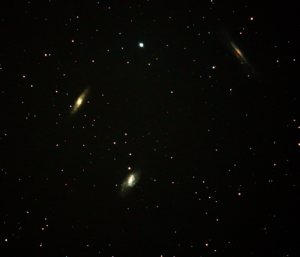Last night was the first Public Session of the season, and it was a “Winner” Fifteen visitors spent some time with us at DHO under so-so skies, and cool weather, but it didn’t seem to bother them at all. A group of comet watchers spread a blanket out on the lawn and played games until darkness fell, but high clouds and light pollution thwarted views of any Lyrid meteors raining down. Several toured the ground to see what Bob O., Tony K., John R had to offer, I was holed up in the chartroom all night with a large TV and a projector/screen combo to entertain several onlookers at once. Ray was the master of Ceremonies with the newly refurbished Cave, and a reporter from SU stopped by to film and interview Ray about our club.
One family said they have immediate plans to join SAS. Their 8-year son (the geek of the family) is already an astronomy buff, and can identify constellations and stars with ease. He’s really into computers and was watching every move I made with my EAA setup. His thoughtful questions belied his young age. I look forward to having that family climb aboard.
Last night was also a “Winner” for the Cave. Our beloved Cave tracked the sky flawlessly as it celebrated its “Second Light” to the adoring public. What a pleasure it was to use our flagship telescope once again. Ray said he focused on the Leo Triplet, then stepped away for 15 minutes and when he returned, the view was exactly the same.
And to complete the trifecta, today could be considered a belated Earth Day for SAS. Our cleanup day was our third success of the weekend. About a dozen, hearty SAS volunteers/members spent hours tackling all 20 chores on my list, and all 20 were completed by 1 PM. So as stupidvisor, I gave them all the rest of the afternoon “off”! Everyone was so cheerful and capable of helping make the place “real perty” once again. Stop by and see the results of their work. We’ll keep the light on fer ya. Seriously, thanks to everyone who took time out of their busy schedules to help us.
Here’s the best image I could muster through the hazy, high clouds.

